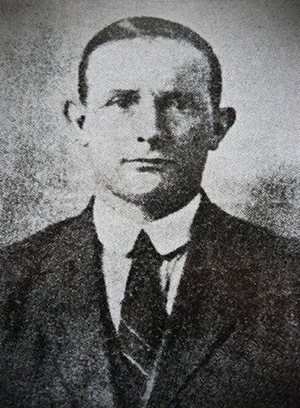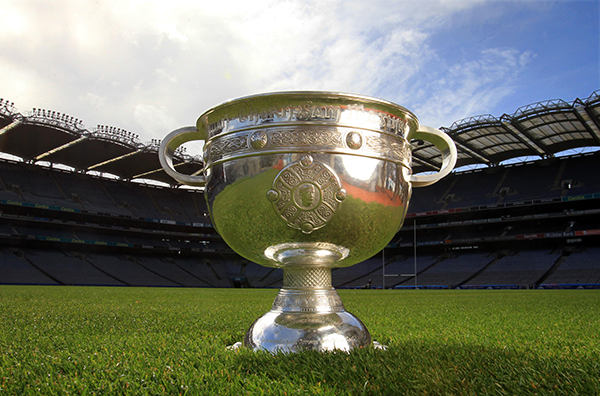Who was Sam Maguire?
Published in 20th-century / Contemporary History, Issue 5 (September/October 2017), News, Volume 256 February 2017 was the 90th anniversary of the death of Sam Maguire, whose name was bestowed on the cup that has been awarded every year since 1928 to the winners of the All-Ireland Gaelic football championship. But who was he?
By Junette Stronge

Above: Sam Maguire—succumbed to tuberculosis on 6 February 1927, almost penniless and all but forgotten. (GAA)
While in London, Maguire immersed himself in the well-established Irish community. He joined the London Hibernians GAA club and captained the team in four consecutive London championships. He played alongside his brother Jack in three All-Ireland senior football finals in Jones’s Road. It is thought that he captained all three teams but unfortunately never obtained a medal. In 1907 he was elected chairman of the London county board and subsequently became a trustee of Croke Park.
In London he appears to have been recruited at an early stage into the Irish Republican Brotherhood (IRB). He is said to have sworn Michael Collins into the IRB and became a firm supporter of his. Accounts differ as to Maguire’s level of seniority within the organisation, but he is thought to have become the centre of the London circle and was involved in smuggling arms to Dublin. As a Post Office employee he was well placed to intercept official British communications and relay them to Dublin.
His brother Dick took ill in 1912 and returned home to Ireland, where he died of tuberculosis. The Skibbereen Eagle of 3 August 1912 refers to the popularity of the family in the Dunmanway area and stated that ‘it was the three Maguire brothers who made the Gaelic Athletic Association of London what is to-day’. The following year, tragedy struck again when Jack died. He was brought home to be buried. The Skibbereen Eagle of 1 November 1913 recounted the highlights of Jack’s sporting career and mourned ‘the loss of another genuine Irishman’.
There is some disagreement about the organisations with which Maguire was involved in London. Patrick Hegarty, who had been prominent in the IRB and worked closely with Maguire from 1903 to 1913, became secretary of the Post Office in Ireland in 1922. His 16 October 1953 witness statement to the Bureau of Military History declared that ‘[Sam] and his two brothers, Dick and Jack—also sorters—were amongst the foremost workers in London in the GAA and in the IRB. They did not touch the Gaelic League or Sinn Féin.’ Hegarty referred to them as a phenomenon owing to the fact that they were Protestant and nationalist, describing them as ‘Irishmen since they were born’. He added that Maguire had been the secretary to the divisional executive of the IRB and probably the main force there after 1918.

Above: Chorn Sam Maguire—but who was Sam Maguire? (GAA)
Maguire moved to Dublin in March 1923 in the face of increasing British suspicions. Hegarty claimed that he arranged Maguire’s relocation to the Department of Post and Telegraphs. On 29 December 1924 he was summarily dismissed from his role as a clerical officer for alleged complicity in the army mutiny. This he denied but was never given the opportunity to refute, despite repeated requests and a Dáil debate on the matter on 13 May 1926. He had been staying with friends in Dublin and after the Dáil debate, in declining health, he returned home to family in Mallabracka, outside Dunmanway.
On 6 February 1927 he died of tuberculosis, almost penniless and all but forgotten. He had spent much of his life in the background of the struggle for Irish independence, and it is possible that his contribution will never be fully known. After his death, money was raised by a group of his friends and a cup was commissioned in memory of his name. This was presented to the GAA in 1928. He is buried with his family in St Mary’s graveyard in his native Dunmanway, where Sam Maguire the man is still remembered, most recently with the installation of the ‘Sam Maguire Community Bells’ in his local church.
Junette Stronge is a genealogist and local historian.
FURTHER READING
M. Cronin, ‘Sam Maguire: forgotten hero and national icon’, Sport in History 25 (2) (August 2005).
J. Stronge, The family of Sam Maguire, Mallabracka, Co. Cork, independent.academia.edu/JunetteStronge (2017).
M. Walsh, Sam Maguire: the enigmatic man (Cork, 2003).
















